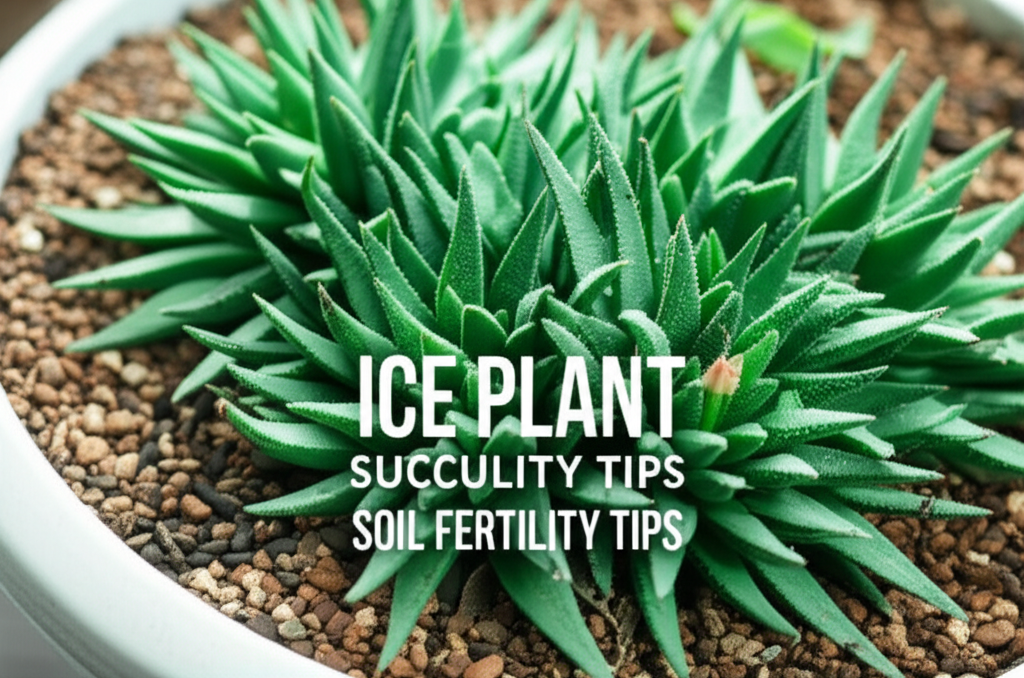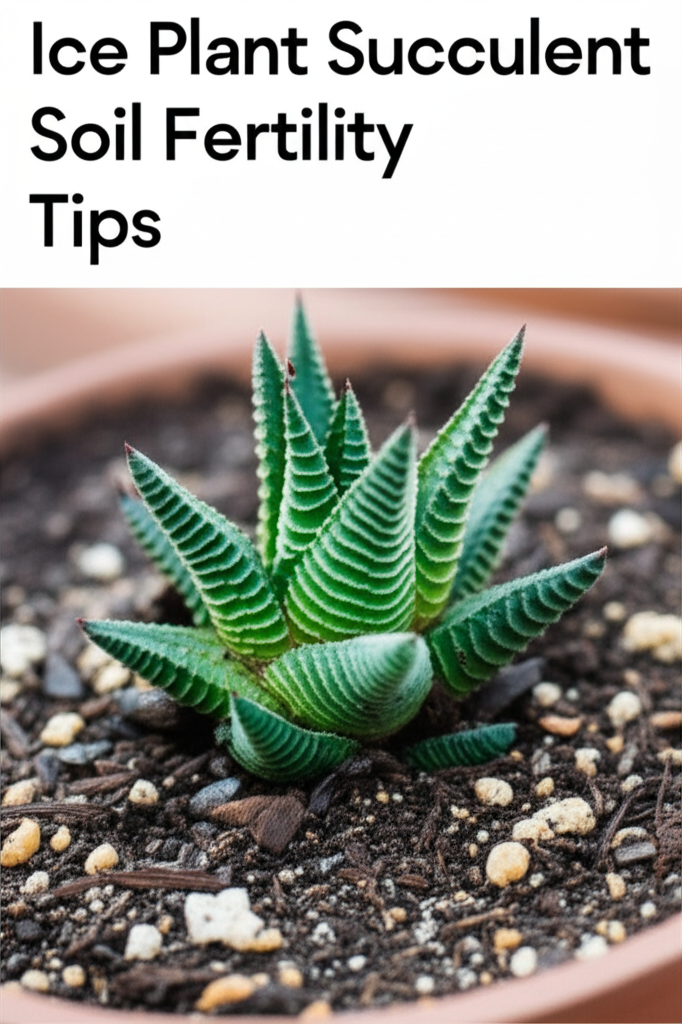The Foundation of Vibrant Growth: Understanding Ice Plant Soil Needs
Ice plants, scientifically known as Mesembryanthemum crystallinum and its relatives within the Aizoaceae family, are celebrated for their unique succulent foliage, often adorned with glistening, crystalline epidermal cells that give them their common name. These captivating plants thrive in arid and semi-arid environments, naturally adapting to soils that are typically nutrient-poor and possess excellent drainage. However, to achieve their full potential in cultivation, understanding and managing their soil fertility is crucial. While they are forgiving, providing the right balance of nutrients, particularly in container settings or where native soil is heavily amended, can significantly enhance their vibrancy, flowering, and overall health.
This article delves into the intricacies of soil fertility for ice plants, offering practical, factual advice for gardeners to cultivate these striking succulents successfully. We will explore the ideal soil composition, essential nutrients, and how to manage fertility to avoid common pitfalls, ensuring your ice plants flourish.
Why Soil Fertility Matters for Ice Plants
While ice plants are inherently adapted to low-fertility soils, this doesn’t mean they don’t benefit from a well-balanced nutrient profile. In fact, optimal soil fertility plays a vital role in:
- Enhanced Growth Rate: Adequate nutrients provide the building blocks for faster and more robust vegetative growth.
- Abundant Flowering: Sufficient phosphorus and potassium are particularly important for stimulating prolific and colorful blooms.
- Improved Disease Resistance: Healthy plants with access to essential micronutrients are generally more resilient to pests and diseases.
- Vibrant Coloration: Proper nutrition can enhance the natural colors and the characteristic “ice” crystals on the leaves.
- Better Water Retention (in balanced mixes): While drainage is paramount, a soil mix that also retains a slight amount of moisture, facilitated by organic matter, can be beneficial between watering cycles.
The Pitfalls of Over-Fertilization
It’s important to note that the majority of issues with ice plants arise not from a lack of fertility, but from its excess. Over-fertilization can lead to:
- Leggy and Weak Growth: Excessive nitrogen can promote rapid, stretched growth that is prone to breaking and lacks the compact form characteristic of healthy ice plants.
- Reduced Flowering: Plants that are too focused on vegetative growth due to over-fertilization may produce fewer flowers.
- Root Burn: High concentrations of salts from fertilizers can damage delicate root systems.
- Increased Susceptibility to Pests: Soft, overly succulent growth can be more attractive to certain pests like aphids and mealybugs.
- “Salt” Buildup: In containers, fertilizer salts can accumulate, altering the soil pH and hindering nutrient uptake.
Ideal Soil Composition for Ice Plants

The cornerstone of successful ice plant cultivation is a well-draining soil mix. This is non-negotiable, as ice plants are highly susceptible to root rot in consistently wet conditions. The ideal mix should mimic their native habitats, which are often sandy or gravelly.
Key Components of an Effective Ice Plant Soil Mix:
- Inorganic Aggregates (50-70%): These are essential for drainage and aeration.
- Perlite: Lightweight, porous volcanic glass that provides excellent aeration and drainage.
- Pumice: Similar to perlite, offering good drainage and aeration.
- Coarse Sand: Horticultural or builder’s sand (not fine play sand) improves drainage and adds grit.
- Gravel/Small Pebbles: Lava rock or pea gravel can further enhance drainage at the bottom of pots or within the mix.
- Organic Matter (30-50%): Provides some nutrients and improves water-holding capacity, but should be used judiciously.
- Cactus/Succulent Potting Mix: A good base, but often benefits from additional amendments for better drainage.
- Compost: Well-rotted compost can add beneficial microbes and a slow-release of nutrients. Use sparingly.
- Coco Coir or Peat Moss: Can be used in smaller quantities for slight moisture retention, but avoid mixes that retain too much water.
Container vs. In-Ground Planting
The approach to soil fertility can differ slightly depending on whether your ice plants are grown in containers or directly in the ground.
Container Growing:
In containers, you have complete control over the soil. It’s advisable to start with a high-quality, gritty cactus and succulent mix and then amend it further. A common and effective ratio is:
- 60% inorganic grit (perlite, pumice, coarse sand)
- 40% potting mix (preferably one with good aeration)
This provides the necessary drainage and avoids the waterlogging that can occur in standard potting soils.
In-Ground Planting:
If planting directly into the ground, assess your native soil. If it’s heavy clay or retains too much moisture, amending is crucial. Incorporate generous amounts of coarse sand, perlite, or pumice into the planting bed. Raised beds are also an excellent solution for improving drainage and controlling soil composition.
Essential Nutrients for Ice Plants
While ice plants are not heavy feeders, a balanced supply of macronutrients and micronutrients contributes to their overall health and aesthetic appeal.
Macronutrients:
- Nitrogen (N): Promotes leafy growth. Use sparingly, as too much can lead to weak, stretched plants.
- Phosphorus (P): Crucial for root development and flowering. Essential for vibrant blooms.
- Potassium (K): Supports overall plant health, stress tolerance, and water regulation. Aids in flowering and fruiting.
Secondary Macronutrients:
- Calcium (Ca): Important for cell wall structure and overall plant strength.
- Magnesium (Mg): A key component of chlorophyll, essential for photosynthesis.
- Sulfur (S): Involved in protein synthesis and enzyme activity.
Micronutrients:
These are required in smaller amounts but are vital for various physiological processes. They include iron, manganese, zinc, copper, boron, and molybdenum. Deficiencies can manifest as yellowing leaves (chlorosis), stunted growth, or poor flowering.
Fertilizing Strategies: When and How
The key to fertilizing ice plants is moderation. They thrive on lean conditions, so less is often more.
When to Fertilize:
The most opportune time to fertilize ice plants is during their active growing season, which typically occurs in spring and early summer. Avoid fertilizing during their dormant period (usually late summer to fall, and winter) or when the plant is stressed due to drought or extreme heat.
How to Fertilize:
1. Diluted Liquid Fertilizers:
This is the most common and safest method for ice plants, especially in containers.
- Use a balanced liquid fertilizer (e.g., 10-10-10 or 20-20-20) diluted to one-quarter or one-half strength.
- Apply during a regular watering session, ensuring the soil is slightly moist before application to prevent root burn.
- Fertilize once a month or every six weeks during the active growing season.
2. Slow-Release Fertilizers:
These can be incorporated into the soil mix at the time of planting or top-dressed sparingly.
- Choose a fertilizer formulated for succulents or cacti, which typically has a lower nitrogen content.
- Follow package instructions carefully and err on the side of using less than recommended.
- Top-dress with a small amount in spring.
3. Organic Amendments:
Incorporating small amounts of compost or well-rotted manure into the soil mix at planting time provides a gentle, slow release of nutrients. Be cautious with manure, as it can be too strong for succulents if not fully composted.
Watering and Fertilizing Synergy:
Always water your ice plants thoroughly after fertilizing. This helps to distribute the nutrients throughout the soil and prevent the concentration of fertilizer salts on the roots. Conversely, if you are fertilizing with a diluted liquid feed, watering your plants a day or two before fertilizing can prepare them for nutrient uptake.
Key Facts and Comparison
Understanding the ideal conditions and how they relate to fertilization can be best illustrated through a comparative table.
| Factor | Ideal Condition for Ice Plants | Common Pitfall (Over-fertilization) | Typical Fertilizer Recommendation |
|---|---|---|---|
| Soil Type | Gritty, well-draining (50-70% inorganic aggregates) | Heavy, water-retentive soils | Cactus/succulent mix with added perlite/pumice |
| Nutrient Level | Low to moderate; thrives on lean conditions | High; can cause root burn and weak growth | Low-nitrogen, balanced formulations |
| Fertilizer Type | Diluted liquid feeds; slow-release sparingly | High-nitrogen, frequent applications | Quarter-strength balanced liquid feed, or low-N slow-release |
| Frequency | Once monthly or every six weeks during active growth | Bi-weekly or monthly at full strength | Apply during watering, not on dry soil |
| Symptoms of Imbalance | Stunted growth, poor flowering | Leggy growth, leaf burn, reduced flowering, pest susceptibility | Yellowing, wilting, mushy stems |
Troubleshooting Common Soil Fertility Issues
Even with the best intentions, issues can arise. Recognizing the symptoms is the first step to correcting them.
Yellowing Leaves (Chlorosis):
While sometimes caused by overwatering or lack of light, chlorosis can also indicate a nutrient deficiency, particularly iron or magnesium. If the plant is otherwise healthy and the soil is well-draining, a diluted micronutrient spray or a light application of a balanced fertilizer might help. Ensure your soil mix isn’t too alkaline, as this can lock up iron.
Leggy and Weak Growth:
This is a classic sign of too much nitrogen or excessive watering. Reduce or stop fertilization immediately. Ensure the plant receives plenty of sunlight, and let the soil dry out between waterings. Pruning can help restore a more compact form.
Leaf Burn or Crispy Edges:
This often points to fertilizer burn from too much salt accumulation in the soil. If in a pot, leach the soil by watering heavily until water runs freely from the drainage holes. For in-ground plants, reduce fertilization significantly.
Lack of Flowering:
A deficiency in phosphorus or potassium can limit flowering. Ensure you are using a fertilizer that contains these elements during the growing season. However, if the plant is very young or recently repotted, it might simply be focusing on root development.
The Process of Soil Preparation and Fertilization
A step-by-step approach ensures you provide the best environment for your ice plants.
| Step | Description | Key Considerations |
|---|---|---|
| 1. Soil Mix Selection | Prepare a gritty, well-draining mix. Aim for a ratio of roughly 60% inorganic components (perlite, pumice, coarse sand) and 40% organic potting medium. | Prioritize drainage above all else. Avoid standard potting soils alone. |
| 2. Planting/Repotting | When planting or repotting, incorporate a small amount of well-rotted compost into the new soil mix for a gentle nutrient boost. | Do not add fresh manure or excessive organic matter. |
| 3. Initial Watering | Water the newly planted or repotted ice plant thoroughly to settle the soil and reduce transplant shock. | Allow the soil to dry out slightly before the next watering. |
| 4. Fertilizing Schedule (Growing Season) | Begin fertilizing in spring as new growth appears. Use a diluted liquid fertilizer (1/4 to 1/2 strength). | Fertilize only during the active growing season (spring to early summer). |
| 5. Application Method | Apply diluted liquid fertilizer during a regular watering session. Ensure the soil is moist before application. | Never apply fertilizer to dry soil, as this can scorch the roots. |
| 6. Observation and Adjustment | Monitor your plants for signs of stress or nutrient deficiency. Adjust fertilization frequency or strength as needed. | Less is more. If in doubt, fertilize less frequently. |
| 7. Dormant Period Care | Cease fertilization during the fall and winter months when the plant’s growth slows or stops. | Reduce watering during dormancy, allowing the soil to dry out significantly between waterings. |
Conclusion: The Art of Balanced Nutrition
Nurturing ice plants is less about aggressive fertilization and more about providing the right environment and a gentle, consistent supply of nutrients. By prioritizing excellent drainage and adopting a conservative approach to feeding, you can ensure your ice plants not only survive but truly thrive. Observe your plants, understand their subtle cues, and adjust your soil fertility strategy accordingly. With the right care, these unique succulents will reward you with their distinctive beauty and captivating crystalline foliage for seasons to come.


